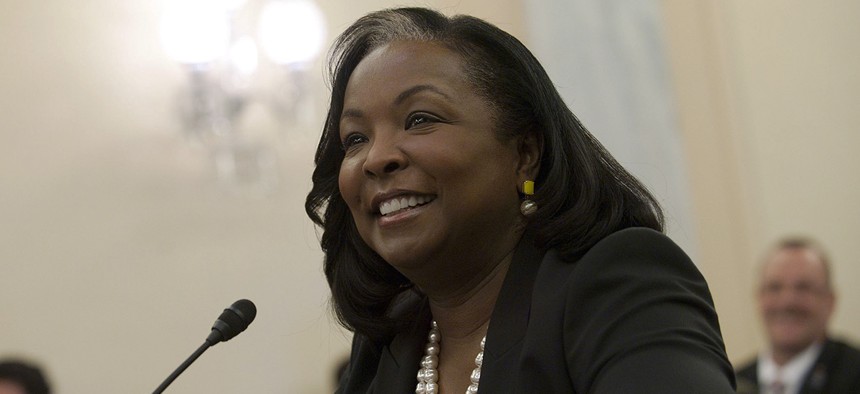Should VA Scrap VistA? CIO Evaluates Future of Home-Grown Health Records System

LaVerne Council, the assistant VA secretary for information and technology. Veteran Affairs Department
The assessment comes amid ongoing concerns about the multiple, failed attempts to develop interoperable electronic health records between VA and DOD.
The new top IT official at the Department of Veterans Affairs told lawmakers Tuesday she is meeting with her staff this week to discuss the future of a planned upgrade of the department’s in-house electronic health record system.
The meeting comes after an independent report by MITRE Corp. concluded the homegrown system, first developed in the 1980s and still highly rated by clinicians, is “in danger of becoming obsolete.”
Amid ongoing concerns about the multiple, failed attempts to develop interoperable electronic health records between VA and the Defense Department, the report recommended VA conduct a cost-analysis of upgrading the Veterans Health Information Systems and Technology Architecture, known as VistA, compared to using open source EHRs and commercial off-the-shelf options.
LaVerne Council, the assistant VA secretary for information and technology and the agency’s chief information officer, will review the business case for the VistA upgrade along with VA Undersecretary of Health Dr. David Shulkin and then “determine the next steps,” Council told a joint congressional subcommittee hearing Tuesday.
VA, DOD Take Separate Paths on EHR Upgrades
In the two years since VA and DOD scrapped a plan to develop an integrated electronic health record, VA has been working on an incremental, multiyear replacement for its system, known as VistA Evolution.
DOD, meanwhile, has taken a completely different tack, awarding a $9 billion contract this summer to a team of contractors, including defense IT firm Leidos and Cerner, to implement commercial EHR technology.
Some lawmakers raised specific questions about VA’s continued reliance on the VistA system.
"Are we at the point where we just can't keep trying to rejigger the technology?” said Rep. Anne McClane Kuster, D-N.H., who cited cited the independent MITRE report, first reported by Politico last week.
Council said no decisions would be made until she’s reviewed the business case for the VistA Evolution upgrade.
“We wanted to have a fact-based conversation about the right next steps should be with VistA,” Council said. “We didn't want to take it from the cuff. . . We really wanted to go into understanding where we are today, where we're hoping to go and will that take us where we need to go for the veteran in the future."
Reviewing the program "is the right thing to do,” Council added. “It's the coherent thing to do. But we want to do it based on having real facts behind us and making sure that we're making the right decision for the veteran in the long term.”
Council, who has said part of her strategy for leading VA’s IT shop is a “buy-first” approach to IT, also defended the “clinical-focused” VistA system. The system, frequently rated more highly than commercial systems by doctors who use it, has “enabled that capability to really drive many breakthroughs,” she testified.
“What we've got to figure out is: What opportunities do we have to continue with it as a backbone and should we be moving with different levels of technology that we haven't used before?” Council said.
'Inherent Duplication,' Missed Deadlines
Lawmakers during hearing Tuesday expressed frustration over the continued delays in full EHR interoperability between the agencies.
Both DOD and VA said in 2013 when they abandoned plans for a single EHR that pursuing separate but interoperable systems would achieve get results faster and more cheaply.
Pursuing separate paths, however, is full of “inherent duplication,” said Valerie Melvin, director of information technology at the Government Accountability Office. Full interoperability between the two departments “is still years away,” Melvin testified -- well beyond the 2017 goal set by the agencies when they were attempting to develop a single, integrated system.
"To this day, I harbor serious concerns about the decision to abandon a goal of a unified, single integrated system for DOD and VA,” said Tammy Duckworth, D-Ill., an Iraq War veteran elected in 2012. “If we're going to spend $11 billion of taxpayer money” -- the original cost estimate of DOD’s massive EHR procurement -- “I don't understand why we wouldn't have invested this astronomical amount of money in a fully functional interoperable system."
In fact, Duckworth wanted to know why, in the wake of the 2013 decision to back away from developing a an integrated joint system, the Pentagon hadn’t simply moved to adopt the existing VistA system.
“And then together, while we're using VistA, we can work toward something else,” Duckworth told Christopher Miller, the program executive officer for the Defense Healthcare Management Systems. “That's how you get them a better system immediately.”
Miller said DOD and VA have different health care missions. Even a joint, integrated system wouldn’t necessarily be a cure-all, he said.
"You can go talk to any major national health care provider, and they will tell you that they struggle when you're talking about regions or they're talking about working across large geographic areas," he said.
It’s not necessarily a technology problem, Miller said. It’s that providers at the local level generate different processes for using even the same system.
“And so, for us to think that just adopting a single system is going to solve all that, I think is a little naive,” he added.
NEXT STORY: Congress to Review FITARA Scorecards Next Week


